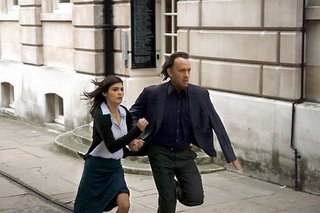

Guess who got shot in the Louvre?
In Jean-Luc Godard’s 1964 classic film Band of Outsiders, his famous trio tries to break the record for the fastest tour through the Louvre. This year, Hollywood is trying to break the record for the most expensive tour through the Louvre. For at least two weeks at the end of June, camera crews will invade the world’s largest cultural staple of art to shoot the movie version of Dan Brown’s international bestseller, The Da Vinci Code.
Not only is the French Cultural Minister, Renaud Donnedieu de Vabres, allowing the project to occur in his country’s most famed national palace, but also he is supporting a more ubiquitous use of French cultural monuments in film. On January 21st, de Vabres invited presidents of France’s principal museums along with film producers in an effort to fuse cinematic production with the spread of French culture throughout the world. De Vabres urged the attendees to increase the number of film productions in national museums.
Hollywood’s international blockbusters have spread American culture throughout the entire world. How many tourists booked rooms in the Plaza Hotel after Home Alone came out? How many parents brought their children to FAO Schwartz to see the life-sized piano from Big? Not to mention the myriad visitors to Texas each year expecting Wayne Newton to gallop over on a horse, pull down his cowboy hat and say: “I reckon this town ‘aint big enough for the two of us.” And I’m sure there were people in third world rural villages a few weeks ago weeping over Brad and Jen’s sudden split.
While many will attribute the ubiquity of American culture to an inevitable universal globalism , it is clear that the cinema is a significant means of cultural transport. In fact, 62% of tourists visiting France claim to have chosen to come to France for their vacation after exposure to the country in a feature film (according to a French Film Commission poll). France’s recent efforts to open the doors of its most precious cultural establishments to film production is not merely a defense mechanism against the invasion of Hollywood’s monopoly, but a means of defending its patrimony.
Some might argue that the latest Gallic trend in “museum movies” is merely a glorified form of product placement on an international scale. As TiVo continues on its quest to take over the world and the younger generation gradually loses its attention span, product placement in movies has become one of the most profitable forms of advertising. If James Bond can sport an Omega watch, carry Samsonite luggage when he flies British Airways, sip Finlandia vodka, shave with Norelco, take pictures with a Kodak camera, talk on a Sony Ericsson mobile phone and drive a BMW, then why can’t Robert Langdon pay a little visit to the Louvre?
He now can, as long as it remains a very brief visit. The museum receives 6.2 million visitors per year, around 20,000 visitors per day who can’t just be turned away because Audrey Tautou is having a bad hair day. Shooting in the Louvre can only occur on Tuesdays or at night when the museum is closed to the public, making it difficult to abridge the shooting schedule.
In this “reverse product placement,” the Louvre not only doesn’t have to pay to see it’s “brand” featured in the film, but it is being paid. Not to mention more money for Dan Brown whose Da Vinci Code has generated specialized tours of Paris which explore the locations mentioned in the novel.
The marriage between film and culture will not only attract film crews to ameliorate France’s economic health and enhance its cultural influence, but it will also bring jobs to
thousands of local film crews struggling to find work in a Hollywoodian hegemonic world.
The Mona Lisa isn’t the only one rolling in the dough recently. Marie Antoinette is also taking in some big bucks from Columbia Pictures. Sofia Coppola recently began shooting Marie Antoinette, produced by her father Francis Ford Coppola and starring Kirsten Dunst, at the Chateau of Versailles, in particular Marie Antoinette’s apartments. Yet Coppola is not the first to feature Versailles on the big screen; in fact, 160 films and 50 documentaries have been filmed in this historical palace. (The Louvre last opened its doors in 1999 for “Belphegor,The Phantom of the Louvre” a mystery film about a ghost haunting the Louvre and stealing precious Egyptian artifacts.)
But will Hollywood’s dominance minimize the artistic experience of visiting such historical sites? Does the Louvre really need 20,000 more tourists to form huge queues and allow only those people over 6’8” to be able to see the Mona Lisa above all those heads?
Not to mention the exorbitant costs of such productions, namely a fee of 50,000 euros per day to shoot in the Louvre. That’s enough to make the Mona Lisa smile.


No comments:
Post a Comment